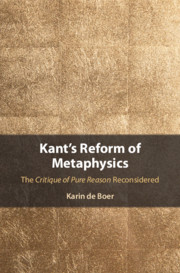Refine search
Actions for selected content:
3 results
Chapter 3 - Ontology, Metaphysics, and Transcendental Philosophy
-
- Book:
- Kant's Reform of Metaphysics
- Published online:
- 20 August 2020
- Print publication:
- 03 September 2020, pp 73-100
-
- Chapter
- Export citation
Chapter 6 - The Schematism of the Pure Understanding
-
- Book:
- Kant's Reform of Metaphysics
- Published online:
- 20 August 2020
- Print publication:
- 03 September 2020, pp 163-190
-
- Chapter
- Export citation

Kant's Reform of Metaphysics
- The Critique of Pure Reason Reconsidered
-
- Published online:
- 20 August 2020
- Print publication:
- 03 September 2020
